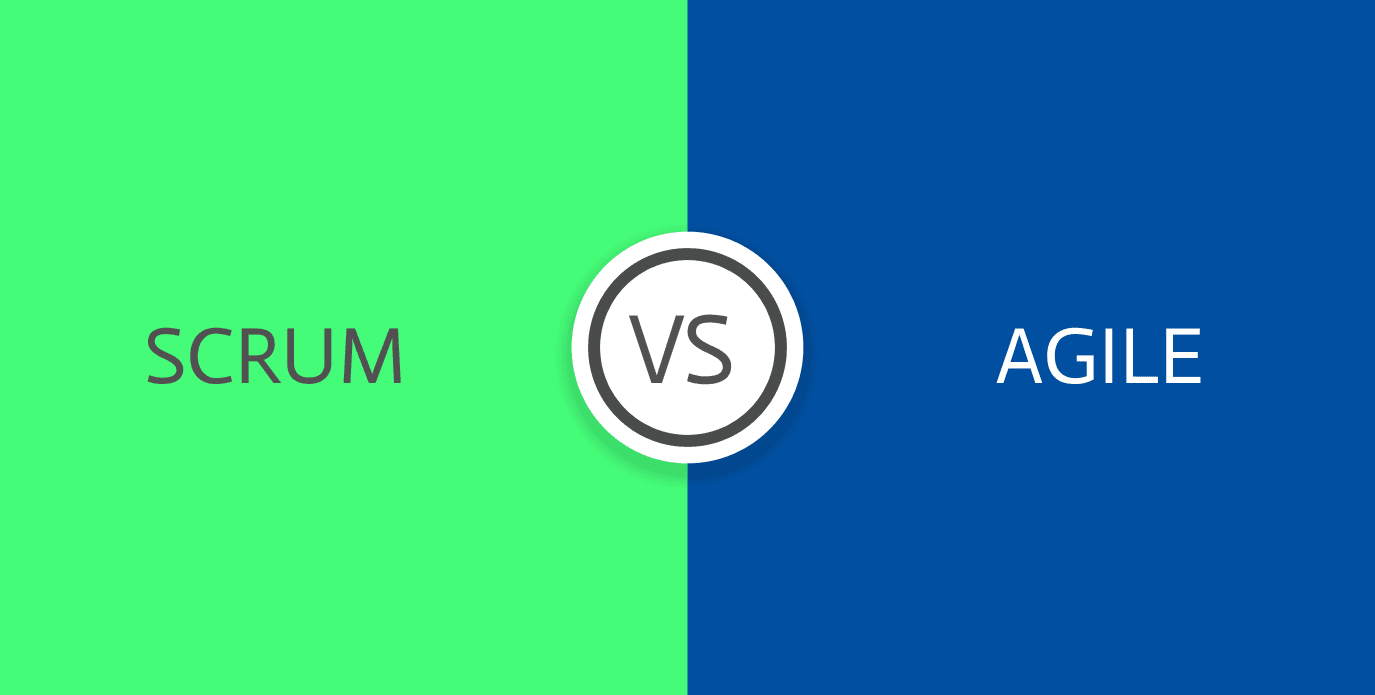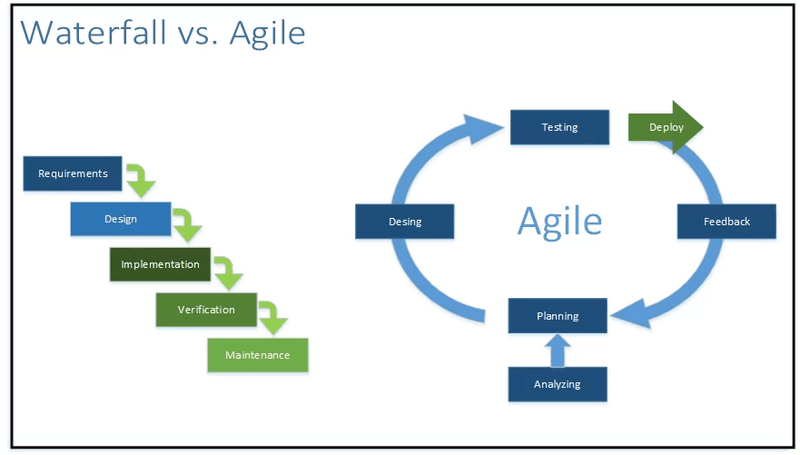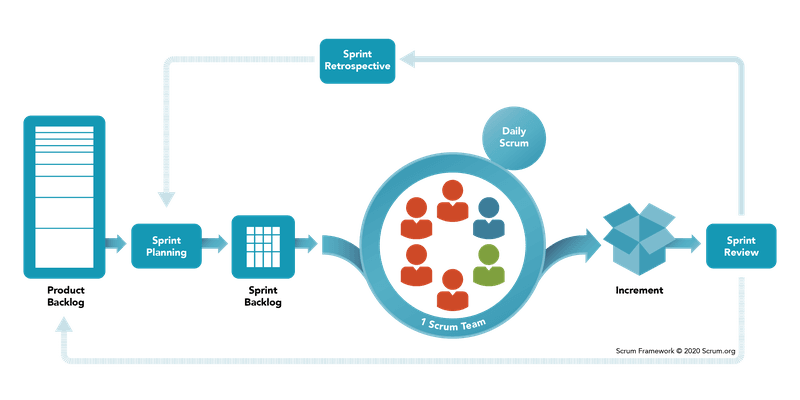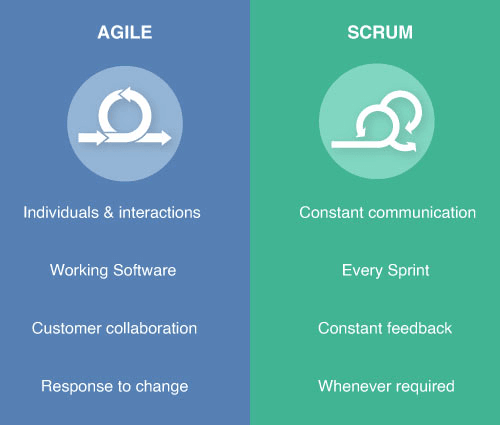
“Scrum” and “Agile” – Do these two terms mean the same thing? If not, what are the differences between these widely used terms?

In this fast-paced era, it is quite impossible to anticipate in advance which software requirements will keep up with the recent trends and which will change.
The traditional plan-driven development approach often fails to cope up with the changing needs of customers. This is where the dynamic “Agile” process comes in. Another common term that is widely used in project management is “Scrum”.
Some people think that the term “Agile” and “Scrum” can be used interchangeably. In reality, Scrum is an Agile method that provides a management framework for the project.
Before we go to further discussion, let’s talk about Agile and Scrum in detail.
Software development model such as the waterfall model needs to follow exact stages. It is not possible to go back to the previous stage to incorporate changes in such a model.
As most of the companies are operating in an environment where changing requirements are a part of everyday life, it is almost impossible to assume a complete set of requirements that will be stable for a long time.
For this kind of situation, Agile software development is the best option.
Agile is a software development process that can easily adapt to changes. In Agile, the whole project is delivered in increments.
Only a set of features that are prioritized by the customer and stakeholders is chosen for each increment. Those sets of features are developed and delivered to customers for use.
Customers then evaluate those features and provide feedback. If necessary, they propose new requirements that can be included in later iterations. The whole project is developed in this manner.
One of the challenging aspects of software development is understanding customer requirements and the best part of the Agile process is customer involvement.
As the customer is involved in each increment during the process, the requirements of the customer can be understood more easily. Moreover, changes of requirements can be incorporated in future increments.
Another benefit of this approach is that after the first increment or a few increments, the software is ready to use. Whereas in other development approaches, users have to wait a long time to use the software.
Waterfall and Agile both are widely used models in software development. But, you can’t randomly choose what to use in your project. To make a wise decision of which one fits perfectly, some factors need to be considered.

If the requirements of your project are clear and you don’t want to involve customers, the waterfall model can be a good option. Moreover, for large projects which involve a huge team, the waterfall model is better.
In practice, it is sometimes difficult to implement the Agile process.
This can be because:
As Agile helps to overcome the problem of changing requirements, it is worth solving these difficulties.
Scrum is a widely used Agile methodology that focuses on managing iterative development by providing a management framework. It is the subset of the wider Agile process. It is a lightweight framework that is simple to understand but not easy to master.
Scrum consists of three phases:

In Scrum, all the requirements are collected from stakeholders to add to the product backlog. New requirements can be added too in the future, as adopting with changing requirements is a feature of Scrum.
After planning with the whole team some features are selected based on their priority from the product backlog. This set of requirements that have been chosen from the product backlog is now in the sprint backlog.
The features in the sprint backlog are completed in a sprint and are implemented by the development team. After 1-4 weeks, the team will give their first increment. If some of the features are not developed in that sprint, they will be transferred in the next sprint. In this way, the whole project will be developed.
Let’s take a look at an example for a better understanding.
Suppose you are planning to build a new social media site. First, you need to collect requirements from stakeholders to create a product backlog. From all the requirements given by your stakeholders, posting status and comments are selected to develop in the first sprint.
Let’s say that the time fixed for each sprint for this project is four weeks. Your development team will develop these two features within four weeks and then the initial software will be sent to the stakeholders.
After getting confirmation from the stakeholders, your team will start working with other important features in the next sprint. This process will continue until the full site is developed and deployed.
Product Backlog is the list of all the tasks that need to be done during the project development. In the planning meeting, the team selects some features from product backlog items usually in the form of user-story.
Sprint Backlog is the list of tasks selected from the product backlog that needs to be completed in a sprint.
The sprint backlog is made by giving priority to requirements through a meeting with the team members. The team selects the important tasks from each user story by discussing them.
Sprints are the main characteristics of Scrum that have fixed lengths, generally 1-4 weeks. As Scrum is an incremental development, only a set of features are selected based on their priorities to develop for each sprint.
At the end of each sprint, completed functionalities are delivered to stakeholders. This process is repeated until the entire project is delivered.
There are three key roles that need to be assigned in every Scrum methodology. They are:
The product owner is an essential part of the Scrum process. A product owner sets the requirements for product backlog and gives constant feedback throughout the life cycle of the project.
Scrum master plays an important role in the Scrum process. The main duty of the Scrum master is to arrange daily meetings, keep track of the works to be done from the Scrum backlog, track progress, and communicate with stakeholders and other members outside of the team.
The members who are in charge of developing the deliverable software are known as the development team. Programmers, Testers, Designers .- all of them are part of the development team.

You might still be confused about the differences between Scrum and Agile. Here’s a list of key differences that you should know.
It is clear from the above discussion that Scrum is a part of Agile. So, there is no option to choose Scrum without Agile. If you are choosing Scrum, you are automatically applying the Agile methods in your project.
But using Agile does not necessarily mean applying Scrum techniques.
If Agile is the perfect method for your project, the next question should be which Agile approach is best for your project?
There are many Agile approaches such as Scrum, Extreme Programming (XP), Dynamic Systems Development Method (DSDM), and more. The two most common approaches are Scrum and extreme programming.
Scrum and Extreme Programming are two popular Agile approaches. Here are some key differences between Scrum and extreme programming:
Changes are inevitable in software project development practices. So, coping up with changes is the best way to stay in the market.
For implementing rapid changes in projects, most companies are adopting the Scrum approach these days. But it is important to remember that Scrum is just a management framework of the Agile software development model.
Looking for a reliable software development solution for your company? PolyUno is here to help. Book a call today!